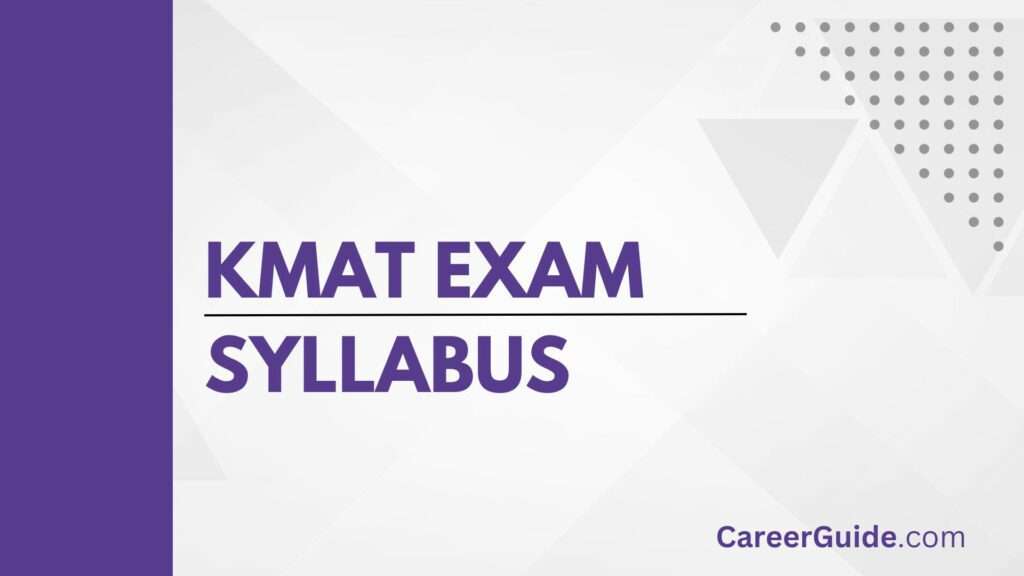The Karnataka Management Aptitude Test (KMAT) is a state-level management entrance examination conducted by the Karnataka Private Post Graduate Colleges Association (KPPGCA). KMAT is a gateway for admission to MBA, PGDM, and MCA programs offered by various B-schools and universities in the state of Karnataka.
To succeed in KMAT, it’s crucial to have a comprehensive understanding of the exam syllabus. In this extensive guide, we will explore the KMAT syllabus in detail, covering various aspects of each section, key topics, and preparation strategies.

KMAT Exam Pattern
Before delving into the syllabus, let’s briefly review the KMAT exam pattern:
- Mode of Exam: KMAT is typically a pen-and-paper-based test (offline mode).
- Sections: The exam consists of three sections: Verbal Ability and Reading Comprehension, Quantitative Ability, and Logical Reasoning.
- Total Questions: The total number of questions may vary from year to year, but it generally ranges from 120 to 180 questions.
- Marking Scheme: Each correct answer is usually awarded 1 mark.
- Negative Marking: As of my last knowledge update in September 2021, KMAT did not have negative marking. This means there is no penalty for incorrect answers.
- Time Duration: Candidates are given a specific time limit to complete the exam, typically around 2 hours.
KMAT Syllabus
Now, let’s dive into the detailed syllabus for each section of the KMAT exam:
1. Verbal Ability and Reading Comprehension:
This section evaluates your language skills, including your ability to understand and analyze written material effectively. Key topics in this section include:
- Reading Comprehension: You’ll encounter passages on various topics and be asked questions that test your understanding of the passage, including its main idea, supporting details, and inferences.
- Vocabulary: Questions related to synonyms, antonyms, analogies, and word meanings are common.
- Grammar: This includes questions on sentence correction, spotting errors, sentence completion, and other grammar-related topics.
- Jumbled Sentences: You may be required to arrange a set of jumbled sentences to form a coherent paragraph or sequence.
- Sentence Rearrangement: Similar to jumbled sentences, this involves rearranging sentences to create a meaningful passage.
- Para Jumbles: These questions require you to arrange a set of sentences to form a coherent paragraph.
Quantitative Ability
The Quantitative Ability section assesses your mathematical skills and ability to solve numerical problems. Key topics in this section include:
- Arithmetic: This includes topics like percentages, ratios and proportions, profit and loss, time and work, time and distance, averages, and simple and compound interest.
- Algebra: Algebraic topics such as equations, inequalities, functions, and quadratic equations are tested.
- Geometry: Geometry questions may involve concepts related to lines, angles, triangles, circles, polygons, and mensuration.
- Trigonometry: Basic trigonometric concepts and identities may be included in the syllabus.
- Data Interpretation: Questions in this category require you to analyze and interpret data presented in various forms, including tables, graphs, charts, and diagrams.
- Number System: Questions related to properties of numbers, divisibility rules, and remainders may be included.
- Probability and Statistics: Basic concepts of probability and statistics, such as mean, median, mode, and standard deviation, may be tested.
Logical Reasoning
The Logical Reasoning section evaluates your ability to think logically, analyze information, and make deductions. It assesses your problem-solving skills and your ability to draw conclusions based on given information. Key topics in this section include:
- Puzzles: Various types of puzzles, such as seating arrangement puzzles, arrangement-based puzzles, and grid-based puzzles, are commonly featured in this section. These require logical thinking and the ability to make connections.
- Blood Relations: Questions related to familial relationships, often involving complex family trees, are asked to assess your ability to deduce relationships.
- Coding-Decoding: These questions involve coding and decoding words or phrases using specific patterns or rules.
- Series: This includes number series, letter series, and mixed series questions that require identifying patterns and predicting the next item in the series.
- Syllogism: Syllogism questions test your ability to draw logical conclusions from given statements using Venn diagrams or other logical methods.
- Direction Sense: Questions related to directions, distances, and movement of objects or individuals.
- Assumptions and Conclusions: You’ll be asked to identify assumptions underlying an argument and draw logical conclusions based on given information.
- Data Sufficiency: These questions assess your ability to determine whether the given data is sufficient to answer a specific question.
Preparation Tips for KMAT
Now that you’re familiar with the KMAT syllabus, here are some tips to help you prepare effectively:
- Understand the Syllabus: Start by thoroughly understanding the syllabus and the topics covered in each section.
- Create a Study Plan: Develop a study plan that covers all sections of the syllabus. Allocate more time to areas where you need improvement.
- Practice Regularly: Regular practice is the key to success. Solve a variety of questions from different topics to enhance your problem-solving abilities.
- Mock Tests: Take full-length mock tests regularly to simulate the actual exam environment. Analyze your performance in these tests to identify areas that need improvement.
- Focus on Weak Areas: Identify your weak areas and work on improving them. Whether it’s mathematics, reasoning, or language skills, targeted practice can make a significant difference.
- Speed and Accuracy: KMAT demands both speed and accuracy. Strive to strike a balance between solving questions quickly and ensuring they are correct.
- Reading Habit: Develop a habit of reading newspapers, magazines, and business articles to improve your reading comprehension skills.
- Stay Updated: Keep up with current affairs and general knowledge as they are often tested in reading comprehension passages.
- Stay Calm: On the day of the exam, stay calm and composed. Avoid last-minute cramming and focus on what you’ve learned during your preparation.
- No Negative Marking Advantage: Remember that as of my last knowledge update in September 2021, KMAT did not have negative marking. So, attempt all questions, even if you are unsure about some.
KMAT 2023 Syllabus Highlights
| Particulars | Details |
|---|---|
| KMAT 2022 Exam Date | September 2023 (tentative) |
| Exam Mode | Internet-Based Test (IBT) |
| Exam Duration | 2 hours |
| Total No. of Questions | 120 |
| Type of Questions | Multiple Choice Questions (MCQs) |
| Examination Sections for CMAT 2022 |
|
| KMAT 2022 Marking Scheme | (+) 1 Mark for every correct answer |
| Negative Marking | No |
| TITA Questions | No |
FAQs
Ans. Yes, the overall syllabus is same for KMAT and CAT, however, there is no DI section in KMAT exam. The difficulty level of CAT is much more than that of KMAT exam.
Ans. Yes, KMAT Syllabus is prescribed by KPPGCA every year.
Ans. No, there is no provision of negative marking in KMAT 2022 exam. Hence, candidates can attempt all questions to the best of their knowledge.
Ans. The KMAT consists of 120 questions and the paper is roughly divided into three sections; thus it is expected to get 40 questions from the Quantitative Ability section.
Ans. KMAT is roughly divided into 3 sections: Language, Quantitative Ability, and Logical Reasoning.










